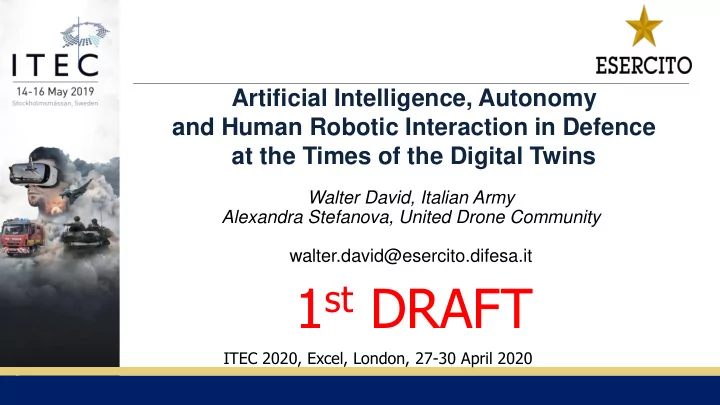

Artificial Intelligence, Autonomy and Human Robotic Interaction in Defence at the Times of the Digital Twins Walter David, Italian Army Alexandra Stefanova, United Drone Community walter.david@esercito.difesa.it 1 st DRAFT ITEC 2020, Excel, London, 27-30 April 2020 #ITEC2019
Agenda Introduction Drones and Artificial Intelligence Lethal Autonomous Weapon Systems Trust, Legal and ethical issues, risks for security Role of simulation Conclusions and Recommendations #ITEC2019
Introduction • Fourth Industrial Revolution: combining hardware, software and biology into complex cyber-physical systems • Autonomous systems lead the Third Warfare Revolution toward ever - increasing autonomous systems • Deployed weapons already at high degree of autonomy. • Super aEgis II sentry turret, Samsung SGR-A1 semi- autonomous sentry gun. #ITEC2019
Drone and AI Challenges • Small drones proliferating as asymmetric weapons • Convergence of drone with affordable AI resources products (for deep neural networks) already present more risks for security. • Unmanned and Autonomous Systems (UAxS) to transform warfare but their use poses multidimensional challenges. #ITEC2019
Approach • Need for multi-dimensional approach • Brainstorming, analysis workshops in the military and innovation sector. • United Drone Community (25 g) Mini SeeK3R • to connect with a neural network, detect and recognize over 100 objects, potentially able to exploit online datasets like Arxiv, Github, Paddle, Keras, MXnet, etc. • Drones of such size are not covered by EU regulations. • Small Unmanned Ground Vehicle VIPER 2 MIL for surveillance, reconnaissance, monitoring and inspection of areas at risk , (e.g. urban buildings, narrow spaces and tunnels, providing real-time information gathered from cameras (visible /IR) and CBR sensors. • UGV technical challenges #ITEC2019
Mini Drone Threat UDC Mini SeeK3R #ITEC2019
Unmanned Ground Vehicles TRP-2 Combat - Leonardo anti-IED robot Dragon Runner, Caddick/AFP/Getty Images VIPER 2 MIL – Ingegneria BEAR - Battlefield extraction assist robot #ITEC2019 7 dei Sistemi
Robotic systems military pros • The perfect soldier, never violating its orders. • Extending the warfighter’s reach . o reach deeper • Force multiplication. Reduction of (human) soldiers. Remove soldiers from most dangerous missions • Better intelligence and situational awareness. • Casualty Reduction of Civilians, and Combatants. Reduction of destruction of critical infrastructures, buildings, properties • Support to disaster management and humanitarian action #ITEC2019
Lethal Autonomous Weapon Systems - LAWS • Lethal Autonomous Weapons Systems do not comply with International Humanitarian Law principles: ? ? • Distinction. • Proportionality in attack. • Precautions in attack. #ITEC2019
Simulation for AI Systems • Trust for humans to team with machines at high levels of autonomy. • Training datasets for machine learning systems in military should perfectly represent real operational data. • Lessons learned and standards from automotive technologies for self- driving vehicles. • L ive, virtual, and constructive simulations a safe, risk-free fashion of the AI systems’ behavior . • Live digital twin model of real world to test missions and to identify failures (unanticipated extreme weather /operating conditions, dangerous hw and sw faults #ITEC2019
Conclusion • Man-machine teams to blend human and AI capabilities • Deep learning to support decision-makers with rapid planning generation #ITEC2019
Solutions & Recommendations • From the legal perspective • A meaningful human control or appropriate levels of human judgement must be retained over weapon systems and use of force, • with the human able to intervene in real-time #ITEC2019
Solutions & Recommendations From the factual/operational perspective • Ethics in AI systems ’ codes of conduct, based on Rules of Engagement and laws, • Digital twin models of robotic system and the environment to be applied to test the AI behaviour under rare and unexpected conditions. • AI trained in crucial aspects of operational planning and decision- making in complex realistic scenarios • urban areas that include models of civilians, wounded combatants, humanitarian actors, weather, road traffic conditions, natural disasters. #ITEC2019
Questions & Answers #ITEC2019
Recommend
More recommend